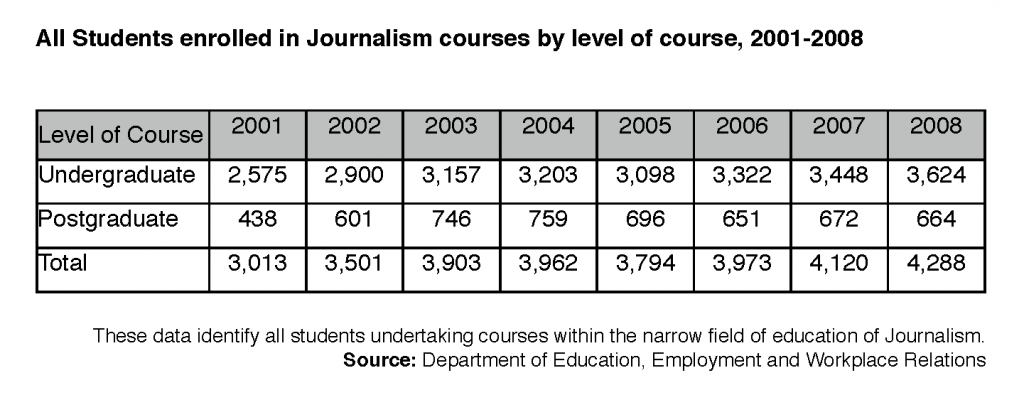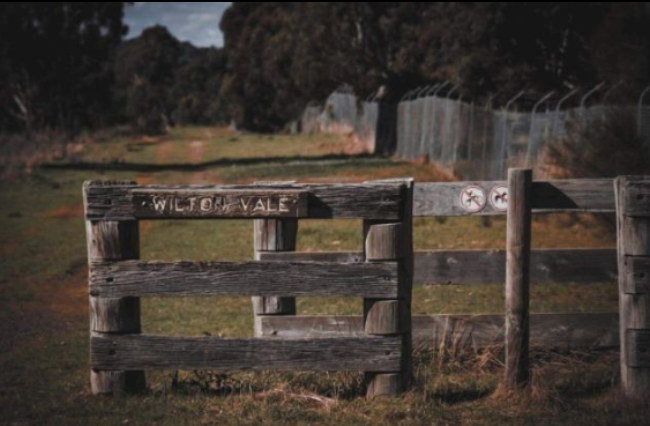A philosophy degree, according to the old joke, is a fastrack to a lifetime thinking deep thoughts about unemployment. In the current media environment, with all the talk about broken business models and job cuts at big media companies steadily sinking under debt, it might seem that a journalism degree is a surefire path to a life of blogging about your experiences at Centrelink.
But if the enrollments in the country’s journalism courses are anything to go by, the attitude of many prospective journalism students is ‘Crisis? What crisis?’
Figures supplied by the Department of Education, Employment and Workplace Relations, show that between 2001–2008, enrollments in journalism courses steadily rose from 3,013 (2,575 undergraduates; 438 postgraduates) to 4,288 (3624 undergraduates; 664 postgraduates).

Enrollments grew faster in journalism courses than overall enrollments in higher education courses; journalism enrollments increased by 42 per cent, while enrollments in higher education courses increased by 27 per cent.
Some snapshots from around the country help to illustrate the statistics. Professor Mark Pearson, head of the School of Communication and Media at Griffith University says ‘Our Bachelor of Journalism enrollments have grown from 25 to 50 in the 05–09 period’.
RMIT University, meanwhile, attracts between 1300–1500 applicants every year for just 40 Commonwealth-funded undergraduate places in journalism. RMIT’s Journalism Program Coordinator Maree Curtis says ‘While the numbers for postgraduates and undergraduates varies from year to year, particularly enrollments of international students, demand has remained steady.’
The growing interest in studying journalism courses isn’t confined to Australia. This year the Columbia Journalism School reported a 44 per cent increase in applications to their Master of Science in journalism program, while applications to their investigative journalism course more than doubled on last year’s results. Other US universities reported similar, though less dramatic, increases in demand.
If journalism — or at least the industry that pays its bills — is in crisis, then why are journalism programs going gangbusters? And what does this say about the journalism of the future?
That journalism courses are growing at a cracking pace, is not as puzzling as it might at first appear. The popularity of journalism is a reflection of the expansion of the media more generally. The same explosion in media that’s causing headaches for execs in the boardrooms of established media companies has also created a new demand for content producers and managers across the board.
While there are a smattering of journalism roles in specialist news and information services, many journalism students go straight into PR roles once they graduate. The basic skill set is much the same for both, even though the way these skills are employed is radically different — or, at least, they should be.
Journalism courses have, accordingly, reinvented themselves to cater to the changed media environment. Many journalism educators are conducting experiments with blogging and social media. Not only are they revising course content to cater to the changed media environment, they’re also tailoring their offerings to the needs of their local communities.
Kate Ames, who co-ordinates the Professional Communication program at Central Queensland University says that her university revamped their journalism degree after, against the national trend, they experienced a drop in student demand. Now re-badged as a professional communication degree, Ames says that they teach the same core journalistic skills — but with greater emphasis on public relations.
‘There is a demand for communication in a broader sense than journalism’, she says.
The changes were made on the understanding that, as a regional university, it isn’t possible — or desirable — for CQU to compete with the large journalism courses offered by metropolitan universities such as UTS and RMIT.
The aim, rather, is to equip students who are able to work as journalists, but also have the skills required to work for small to medium-sized firms in regional areas, where they have to be a Jack or Jill-of-all-trades, with the ability to write copy, create websites and design and layout publications, simply because there isn’t anyone else to do it. The result of the change has been an increase in employer demand.
‘We can’t pump out enough students to meet regional demand’, says Ames. ‘We get at least one request a week for interns’.
The growth in PR and non-traditional media production roles isn’t just a regional phenomenon. Organisations, many of which previously would be thought to have only minor media offerings, are beefing up their media output simply because the bar to publishing high quality content is so low.
Universities themselves are cases in point. When, recently, ABC managing director Mark Scott gave a lecture at the University of Melbourne, the whole event was quickly published on the University’s Live@Melbourne site. (Watch it here.)
Other universities are creating mini-documentaries and stories published on the web and via platforms such as iTunes. While, again, much of this falls into the category of PR, the raw skill set is pretty much the same as for a journalist.
It’s not all PR however. Some students — although a minority — are using their skills to set up their own publications, while others are finding work in news services aimed at specialist audiences. Recent graduates from the journalism course I teach have been picked up by regional newspapers, paid blogging gigs for sports sites, a specialised online news service catering to the not-for-profit sector, not to mention jobs at SBS and newspapers.
The upside of all of this change is that students graduating from journalism courses ought to have the ability to identify a story and write it up, but also have a solid grounding in some form of production, whether it’s website production, video/audio production, either for broadcast or via the web or for print publication.
The danger, however, is that the growth of PR roles may further blur the lines between PR and journalism. If many of today’s students end up in PR or internal communications roles, then it is possible to see a future in which many university trained journalists never practice the critical and investigative skills they learn during their degree.
This isn’t to bash PR practitioners or PR courses. On the contrary, public relations can be and often is a useful activity. Nor is it to suggest that no journalist should ever work in PR. No doubt, some exposure to the world of PR is good for journalists, if they are to be trained to handle the steady stream of corporate information flowing into their inboxes.
The problem lies when the distinction between PR and journalism collapses entirely. If journalism students never actually practice journalism, then the future of journalism may be wall-to-wall ‘churnalism’.
This article was first published in Crikey.com.au
Christopher Scanlon teaches journalism at La Trobe University and is a co-founder of https://www.upstart.net.au






